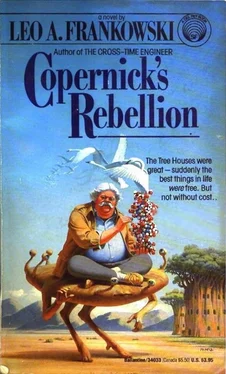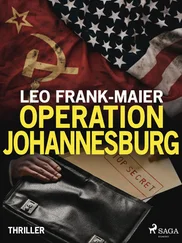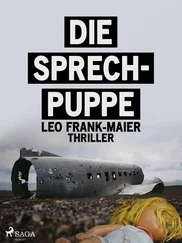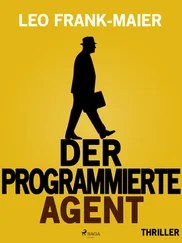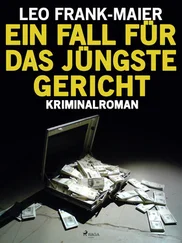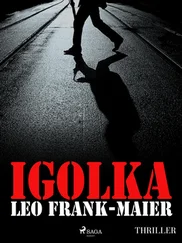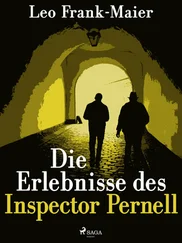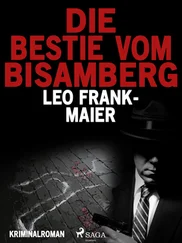“In the absence of any active role on our part, the probability of total nuclear war in the next fifty years is point seven two, due primarily to proliferation of atomic weapons among the smaller nations. Due to increased mobility between population centers, increased population in the underdeveloped nations, and a general lowering of living standards, the probability of devastating plague by 2050 is point eight eight. Extrapolating present demographic trends, by 2050 the population of the underdeveloped nations will outnumber that of the developed nations twenty-seven to one. The probability of the increased population’s resulting in famine and causing a conventional war which will mutate to an unsurvivable thermonuclear war is point nine three. Famine could be delayed by increased industrialization, but the resultant pollutants would render the world uninhabitable by 2090. The net probability of civilization surviving on Earth is point zero two at 2050, approaching point zero zero by 2100.”
There were no formal laws or rules in Life Valley, so there was no formal prohibition of mechanical transportation. However, the general layout of houses, parks, fields, and shops was such that anything larger than a bicycle would have a hard time getting through, and, in fact, most people walked.
Very few people considered it a hardship. Since the necessities were produced in each home, the only commerce was in luxury items, and such things are easily carried.
“It’s incredibly beautiful here,” Patricia said. What was once a horrid jungle to her now seemed a fairyland, yet she did not notice her own change in attitude. “It’s as though every path was asking me to walk down it.”
“Heinrich and Uncle Martin spent a lot of time on the design,” Mona said. “Notice that no matter what time of day it is, the trees and shrubs are arranged so that on any path you can walk in either the sun or the shade.”
“And the way everything curves, Mona. With every step, the view changes, something else shows up.”
“That was part of the plan, too.”
Clothing styles in the valley were varied and occasionally bizarre. A fair number of people followed Guibedo’s lead, wearing ethnic costumes, while others ranged from blue jeans to complete nudity. Mona wore a sarong around her hips and a smile.
Patty, still in businesslike microshorts and transparent top, felt a little out of place, and said so.
“No problem for now, Patty. Just take off your top if you’re hot. But you should have something formal for tonight. Perhaps a chiton, since they’re doing Stravinsky’s Oedipus Rex at the bandshell tonight and Heinrich promised to take me. You can work on Uncle Martin at dinner.
“Anyway, next stop’s at Nancy Spencer’s. She’s the best seamstress in the valley.”
“Ach!” Guibedo’s face was white. “We knew it was going to be bad. That’s why we started the biological revolution. But I never thought it would be this bad. Heiny, have you double-checked all this? Is it really true?”
“I funded a research group with the Rand people six months ago. I got their report this morning. Their figures are substantially the same as the CCU’s.”
“Then we got no choice. We got to fight. You have a strategy worked out for it yet?”
“The CCU and I have been working on it for weeks. While the LDUs can hold their own against conventional troops, they are only marginally effective against armor. They are totally ineffective against air power. When I designed them, I was thinking in terms of a police force and a medical corps. I didn’t realize then that we would be facing a real war. No bird I could possibly come up with could stand a chance against aircraft, let alone orbital beam weapons.
“Our only possible strategy is dispersion, using basic guerrilla tactics over a wide area. Logistics must be handled locally, since we must presume that all of our strong points, including Life Valley, will be obliterated.
“What we need, Uncle Martin, is a tree that doesn’t require someone living in it. That merely provides food for people and the LDUs. Something that is more vigorous than natural plants, so it will supplant them. Something that reproduces with spores rather than seeds, so our opponents can’t stop their proliferation.”
“Sure, Heiny, I could do that. But maybe I better give the species a finite lifespan, so we get rid of them after the war.”
“Good idea, Uncle Martin. But this war could last fifteen years.”
“So long?”
“Guerrilla wars are like that.”
“But why does it have to be a guerrilla war, Heiny? They’ve got to be the worst kind. How about the socialist and communist countries? They’re growing my trees. Why can’t we just move there? If we go to China and they attack us, they’re attacking China, so we have an ally!”
“The Eastern Bloc is growing trees because it solves some of their short-term problems. They haven’t yet realized that when the means of production and distribution are in each man’s own home, he doesn’t need a central government any more. Eventually the commissars are going to realize that they are being put out of work. People who run governments like running governments. We don’t have any allies, Uncle Martin.”
“Yah. The big-shot problem. But still, there’s got to be a better way. So what are our chances of winning this war, anyhow?”
“Quite good, my lord,” the CCU said. “I estimate a point two two probability of success.”
“That’s good?”
“It is, my lord, compared to the probability that civilization will cease to exist within the next century if we do not fight this war.”
“You figured out how many people are going to die in this thing?”
The CCU said, “Best estimates are around two hundred million—two percent of the world’s population, my lord—assuming that we make preserving human life a major strategic objective.”
“So many! You say that so easy, sitting here,” Guibedo said.
“My lord, I am sentient. I do not want to die. But I am immobile, in the center of our opponent’s major target area. In none of the scenarios that we have examined do I have any chance of survival. The probability that I will be dead within two years is one.”
“Sorry, fella,” Guibedo said. “Don’t tell me what my own chances are.”
“My lord, throughout history, every major social, political, or religious upheaval has caused the death of from three to five percent of the population involved. The industrial revolution cost four point two percent of England’s population through starvation and disease. The Russian Revolution cost three point seven percent; the French Revolution, three point six percent; the American Revolution, one point one percent plus an equivalent two point three percent foreign troops. Even the ‘peace—fill’ division of India and Pakistan starved out or killed three point five percent of the population.
“The two percent estimate I gave you for the upcoming revolution was based on the assumption of the loss of one billion LDUs and similar beings. This time, perhaps we can do some of the dying for you.”
Heinrich Copernick and Martin Guibedo were silent for a long while.
Patricia and Mona walked through a series of meadows that dotted the sides of a clear brook, passing over a dozen small bridges. As they did so, the path wound and twisted past and over trout ponds, grottoes, and fountains; it was the antithesis of a superhighway, designed not to be efficient but to make each step of a journey pleasant and interesting.
The path eventually opened onto a long curving meadow. On both sides were tree houses fronted with shops. The owners evidently lived behind their shops, for the stores were small and the houses were large.
Читать дальше
